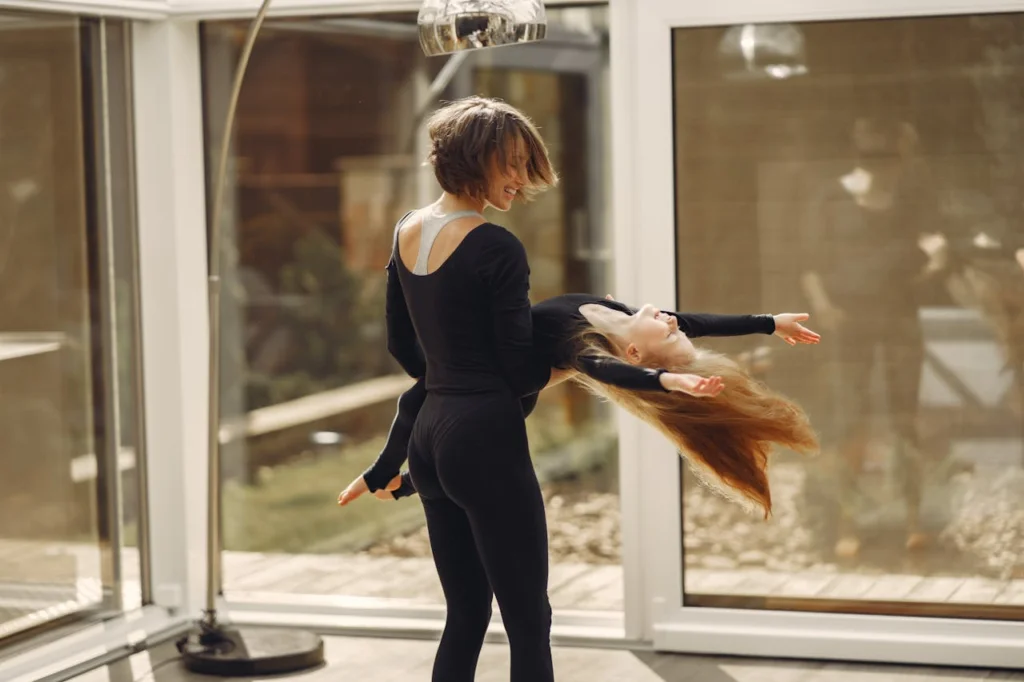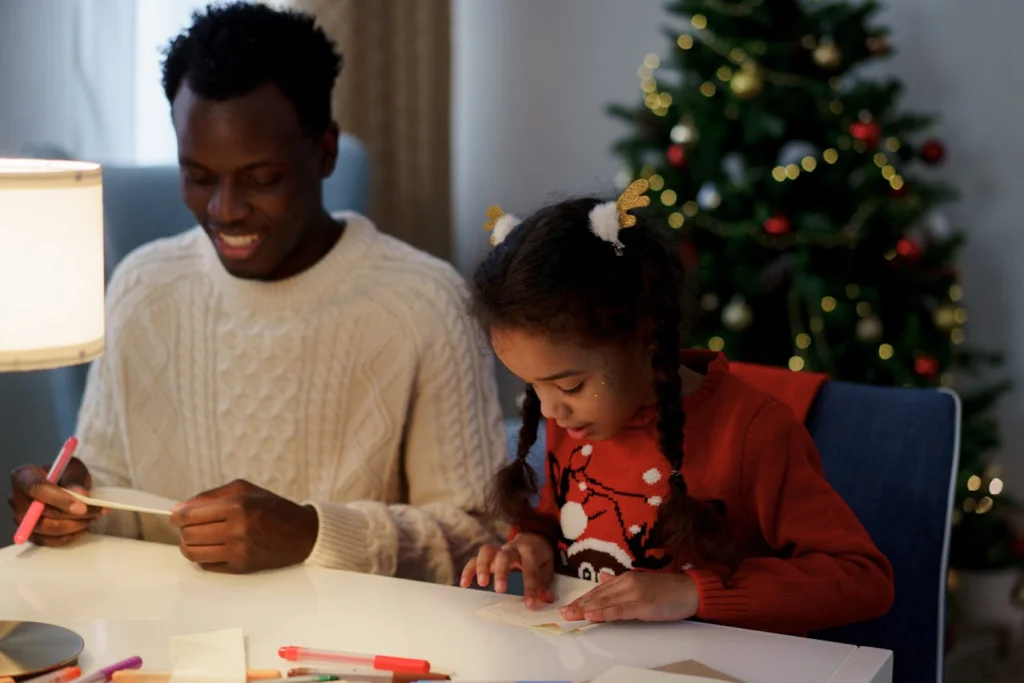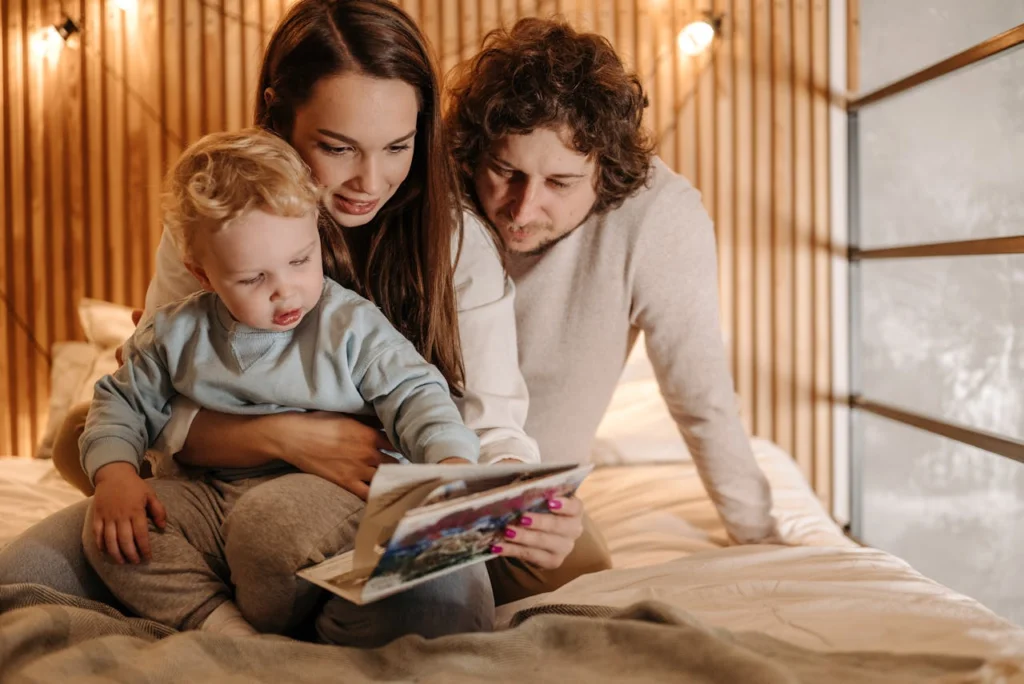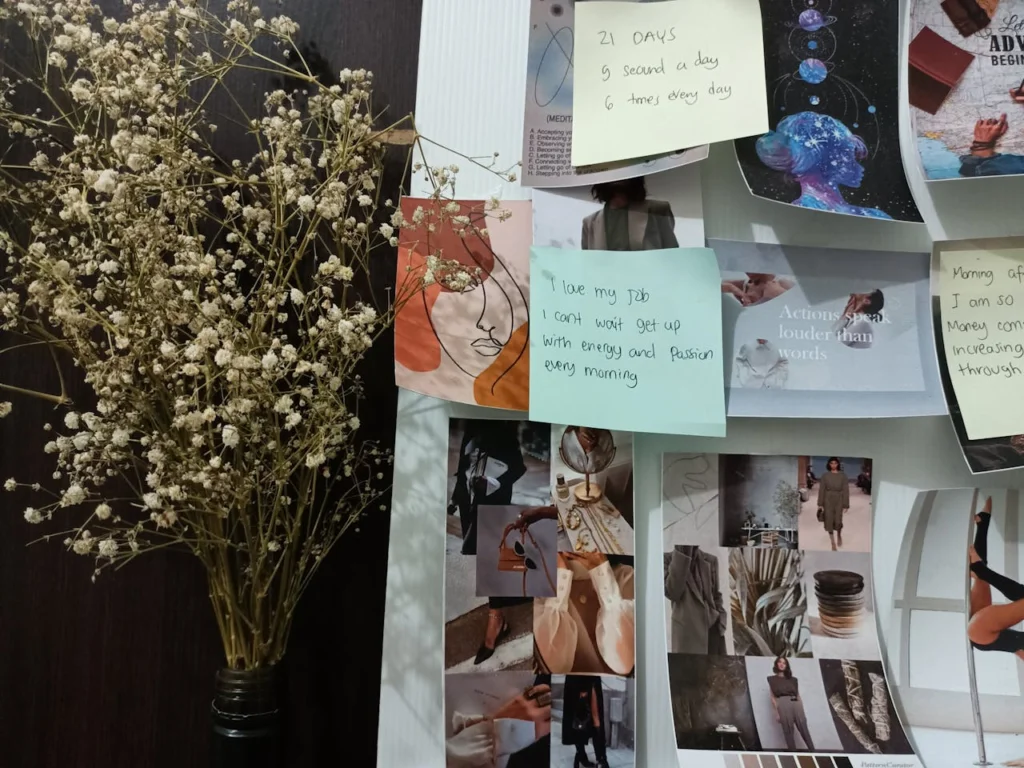
A simple guide to bringing your family closer through shared goals
Think about your favorite family memories. Maybe it was a special vacation, moving to a new house, or achieving something important together. What if you could create more of those amazing moments on purpose? That’s exactly what family vision boards help you do.
A family vision board is like a big poster filled with pictures of things your family wants to do, have, or become together. It’s different from individual vision boards because everyone in the family helps create it and works toward the same goals.
Why Family Vision Boards Work So Well
When one person has a dream, they might work on it alone. But when your whole family shares the same dream, something magical happens. Everyone starts helping in their own way to make it come true.
Imagine your family wants to go on a camping trip. If only one parent is planning and saving for it, progress might be slow. But when everyone sees pictures of that camping trip on your family vision board every day, amazing things start happening. Your kids might suggest packing lunches instead of buying them at school to save money. Your teenager might offer to babysit for neighbors to earn extra cash. Your spouse might find deals on camping gear.
Scientists who study how our brains work have discovered something interesting. When we look at pictures of our goals every day, our brains become much better at noticing opportunities to achieve those goals. It’s like when you learn about a new type of car and suddenly start seeing that car everywhere. The cars were always there, but now your brain pays attention to them.
This effect becomes even stronger when your whole family is looking at the same pictures and working toward the same goals. You’re all training your brains to notice the same opportunities and solutions.
Understanding Your Family’s Unique Situation

Every family is different, and that’s perfectly okay. Your family vision board should work for your specific situation, not copy what other families do.
If you’re a single parent, creating a vision board with your children can be a wonderful way to spend quality time together while planning your future. You get to show your kids that dreams are possible with planning and hard work.
If you have two parents in your home, vision boards help you practice working together as a team. Your children see how adults can have different ideas but still find ways to agree on shared goals.
Some families include grandparents, stepparents, or other relatives living together. These families often create the most interesting vision boards because they combine different experiences and ideas from multiple generations.
The key is making sure everyone in your family feels heard and included, no matter how your family is structured.
How Different Ages Can Help
Understanding what kids can do at different ages helps everyone participate in meaningful ways. Let’s break this down by age groups.
Little Kids (Ages 3-6)
Young children have the most amazing imaginations. They might suggest ideas that seem impossible, like flying to the moon or having a pet dragon. Don’t worry about whether their ideas are practical right now. Their creativity often sparks ideas that lead to real family adventures.
At this age, kids learn best through their senses. Let them touch different materials and use bright colors. Ask simple questions like “What would make our family happy?” or “Where should we go together?” Their answers might surprise you with their wisdom.
Elementary School Kids (Ages 7-12)
Children this age understand that actions lead to results. They can see how saving money leads to buying something special, or how learning new skills helps you do new activities. This makes them excellent contributors to family vision boards.
These kids love to research and learn about your family goals. If you want to visit a national park, let them look up information about the park. They might discover activities you didn’t know about or find ways to save money on your trip.
Elementary school children also love tracking progress. They get excited about charts that show how close you are to reaching your goals. You can turn achieving family dreams into a fun game that everyone enjoys playing.
Teenagers (Ages 13-18)
Teenagers want to feel like their opinions matter in family decisions. They’re developing their own identities while still being part of your family. The trick is giving them real responsibility while keeping them connected to family goals.
Let your teenagers take charge of researching big family decisions. If you’re thinking about moving to a new city, ask them to research schools, neighborhoods, and activities for young people. If college planning is part of your family’s goals, involve them in researching schools and costs.
Teenagers are usually excellent with technology. They might create digital versions of your vision board, set up social media accounts to track your family’s progress, or find apps that help organize your goals.
Creating Your Family Vision Board Step by Step
Let’s walk through the process of creating your family vision board together. Think of this as a fun family project that happens over several days or weeks, not something you have to finish in one afternoon.

Step 1: The Family Dream Session
Pick a time when your family feels relaxed and happy. Turn off phones, tablets, and the television. Get some snacks that everyone enjoys and sit somewhere comfortable.
Start by asking everyone to share their dreams for your family. What would they love to do together? Where would they like to live? What kind of activities sound fun? What would make your family even happier than it already is?
Write down every single idea, even ones that seem silly or impossible. Remember, you’re not committing to everything right now. You’re just collecting dreams and seeing what excites your family.
This conversation might last thirty minutes with young children or two hours with teenagers who have lots to say. Follow your family’s energy level and attention span.
Step 2: Organizing and Choosing Your Goals
After you’ve collected all those wonderful ideas, it’s time to organize them into groups. You might have categories like “Places We Want to Visit,” “Things We Want to Do at Home,” “Ways We Want to Grow as a Family,” and “Things We Want to Learn Together.”
Now comes the important part of choosing which goals to focus on first. Not every idea will make it onto your vision board, and that’s perfectly fine. This teaches your family valuable lessons about making choices and setting priorities.
Talk about which goals feel most important to everyone. Which ones would make the biggest positive difference in your family’s happiness? Which ones are possible to achieve in the next year or two?
Consider having both short-term goals that you can achieve quickly and longer-term dreams that might take several years. The short-term goals keep everyone motivated while you work toward bigger dreams.
Step 3: Finding Pictures for Your Dreams
Now comes the fun part of finding images that represent your family’s goals. This is where everyone can contribute based on their age and abilities.
Younger children might cut pictures from magazines or draw their own pictures of family goals. Older kids can search for images online and print them out. Parents can help find pictures that represent more abstract goals like “better family communication” or “financial security.”
Don’t limit yourselves to obvious pictures. If your family wants to communicate better, you might include images of families playing board games together, sharing meals without phones, or having conversations in comfortable living rooms.
Create a collection box or folder where everyone puts the pictures they find. This might take several days as family members discover images that represent your shared dreams.
Step 4: Designing Your Board Together
Choose whether you want to create a physical poster board or a digital version that you can display on a computer or tablet. Both options work well, so pick whatever feels most comfortable for your family.
Let everyone participate in arranging the pictures on your board. Take turns placing images and deciding where different goals should go. This collaborative process helps everyone feel ownership of the final result.
You might organize your board by time periods, like “This Year,” “Next Few Years,” and “Someday Dreams.” Or you could organize by categories like “Adventures,” “Home,” and “Learning.” Choose whatever makes sense for your family’s goals.
Step 5: Making Your Vision Board Part of Daily Life
Put your completed vision board somewhere that your family sees it every day. Popular spots include the kitchen, family room, or a hallway that everyone uses regularly. The goal is making sure everyone sees your shared dreams frequently.
Create simple daily habits that keep your goals active in your family’s mind. You might look at the board together during breakfast or talk about one goal before bedtime. Some families take a photo with their vision board once a week to track their progress over time.
Plan regular family meetings to talk about how you’re doing with your goals. These might happen once a week during dinner or once a month as a special family activity. During these meetings, celebrate progress you’ve made and brainstorm solutions for any challenges you’re facing.
Dealing with Different Opinions

Creating a family vision board will definitely bring up different opinions and disagreements. These moments are actually valuable opportunities to practice important family skills like listening, compromising, and creative problem-solving.
When family members want different things, try to understand why each goal matters to that person. If one child wants beach vacations while another prefers mountains, explore creative solutions. Maybe you could alternate between different types of trips each year, or find locations that offer both beaches and mountains.
Use disagreements as chances to teach negotiation skills. Help family members explain why their ideas are important while listening respectfully to other viewpoints. Often, goals that seem completely different can be combined in creative ways when everyone understands what each person really wants.
Remember that not everyone has to be equally excited about every single goal. The important thing is finding enough shared enthusiasm to move forward together while respecting that family members have different interests and priorities.
Using Technology to Help Your Family
Modern families can use various apps and websites to make vision boarding easier and more engaging for everyone.
Milanote works well for families because multiple people can add pictures and ideas to the same board from different devices. This means your teenager can add images from their phone while you’re adding ideas from your computer.
Pinterest serves as both a research tool and a place to create your digital vision board. Create a secret family board where everyone can save images and ideas. Pinterest will start suggesting related content, which might give your family new ideas you hadn’t considered.
Canva offers templates specifically designed for family activities and has collaboration features that let family members work on the same design from different locations.
For families with teenagers who prefer digital communication, Padlet works like a digital bulletin board where everyone can post images, videos, and text from any device.
Teaching Money Skills Through Your Vision Board
Family vision boards provide natural opportunities to teach children important lessons about money management and financial planning. When kids see the real costs of family goals, they develop realistic understanding of how money works in family decisions.
Start with age-appropriate money education. Young children can learn that money comes from work and that achieving family goals requires saving over time. Older children can understand more complex concepts like budgeting and the difference between needs and wants.
Create visual ways to track your progress toward financial goals. Use charts that look like thermometers or circles that fill up as you save more money. Children love seeing concrete progress, and these visual tools keep everyone excited during longer saving periods.
Involve children in finding ways to spend less money or earn more money for family goals. They often suggest creative solutions that adults might not think of. When children contribute their own ideas, they feel more invested in achieving family financial goals.
Building Special Family Traditions

Transform your vision board into the center of meaningful family traditions that bring you closer together while keeping everyone focused on shared goals. These special rituals create positive feelings about goal-setting while building excitement for future achievements.
Consider creating an annual vision board celebration each January. Gather as a family to celebrate what you achieved the previous year and create your new vision board for the coming year. Include special foods, music, or activities that make this event feel important and memorable.
Monthly vision board check-ins can become special family time that everyone looks forward to. Create themed discussions around different aspects of your goals or celebrate small steps of progress with appropriate rewards.
Take photos and videos of your vision board journey throughout the year. Create annual family movies showing how your vision board changed and which goals you achieved. These recordings become precious family memories while showing everyone the power of working together toward shared dreams.
Real Stories from Real Families
Learning about other families’ successes can inspire and encourage your own family’s vision board journey.
Maria Santos shares her family’s story about buying their first house together. Their eight-year-old daughter found a piggy bank at a garage sale and started saving her allowance for “our new house fund.” Her enthusiasm motivated both parents to reduce unnecessary expenses and increase their savings rate. Eighteen months later, they moved into their dream home.
David Kim tells about how his family’s vision board helped his teenagers actually get excited about family game nights and outdoor activities. Seeing their goals visualized together helped his children understand that family time wasn’t punishment but investment in relationships they all valued.
Jennifer and Mark Thompson used vision boarding to help their blended family create new shared goals that honored everyone’s background while building fresh family experiences. Now they have traditions that truly belong to all of them rather than feeling like they’re following one parent’s old rules.
Common Challenges and How to Solve Them

Every family faces certain challenges when creating and using vision boards. Understanding these common problems ahead of time helps you prepare solutions.
Different family members will have varying levels of enthusiasm for goal-setting activities. Some children dive into vision boarding with unlimited excitement while others participate reluctantly. Some parents feel excited about certain goals while feeling overwhelmed by others.
Address these energy differences by letting different family members take turns leading discussions. Make sure quieter family members have opportunities to share their thoughts privately if public sharing feels uncomfortable.
Break larger vision boarding sessions into smaller, more manageable activities. Some families prefer multiple short sessions over several weeks rather than one intensive day of planning.
Children especially struggle with understanding how their personal dreams fit within family objectives. They might want individual goals represented on the family board or feel disappointed when their specific interests don’t align with family priorities.
Create space for individual goals that support family objectives. If a child wants to learn a musical instrument, explore how their performances might become part of family entertainment or bonding activities.
Consider creating small individual boards alongside the main family board. This approach honors personal development while maintaining focus on shared family dreams.
Initial excitement for family vision boards often fades as daily routines take over. Families might create beautiful boards that eventually become ignored wall decorations rather than active goal-setting tools.
Combat this motivation loss through regular engagement activities and progress celebrations. Plan specific dates for vision board reviews and stick to these commitments even when life gets busy.
Update your board regularly as goals change or are achieved. Boards that never change become stale, but boards that reflect current family dreams maintain relevance and excitement.
The Long-Term Benefits for Your Family

Families that consistently practice vision boarding together report stronger communication, increased cooperation, and deeper understanding of each other’s hopes and dreams. These benefits extend far beyond achieving specific goals into overall family happiness and functioning.
Children who grow up with family vision boarding develop stronger goal-setting skills that benefit their school performance, future career development, and personal relationships. They learn that dreams require planning and persistence while understanding that family support makes achievement more likely and more meaningful.
Parents find that shared visioning reduces family conflicts around priorities and how to spend money. When everyone understands and contributes to family goals, daily decisions become easier because they align with objectives everyone agreed upon together.
The practice also strengthens family identity and helps clarify what values matter most to your family. Through the process of choosing shared goals, families discover what matters most to them collectively while building traditions that reflect their unique priorities and interests.
Starting Your Family’s Vision Board Journey Today
Creating a family vision board represents an investment in your family’s future happiness and success. This practice transforms scattered individual hopes into powerful collective momentum while teaching children valuable life skills they’ll use forever.
Remember that perfect vision boards don’t exist. Your family’s board should reflect your unique situation, dreams, and circumstances. Focus on creating something that genuinely excites your family members rather than trying to copy someone else’s approach or meet external expectations.
The most important step is simply beginning. Gather your family, start the conversation, and begin collecting images that represent your shared dreams. Six months from now, you’ll be amazed at the goals you’ve achieved and the stronger relationships you’ve built through this powerful practice.
Your family’s greatest adventures and achievements are waiting to be created through the power of shared visualization and working together toward common goals. Start creating your family vision board today, and begin building the future your family truly desires.
Think of your vision board as planting seeds for your family’s future happiness. With regular care, attention, and the combined efforts of everyone in your family, those seeds will grow into the beautiful reality you’ve dreamed of together.
Ready to bring your family closer while achieving shared dreams? Save this guide and start your family vision board adventure today! Share your family’s progress and inspire other families on Pinterest.
Comments
-
Pingback: 5 Future Goals That Make You Happy Now





Pingback: 15 Ways to Cultivate Patience in a Fast World